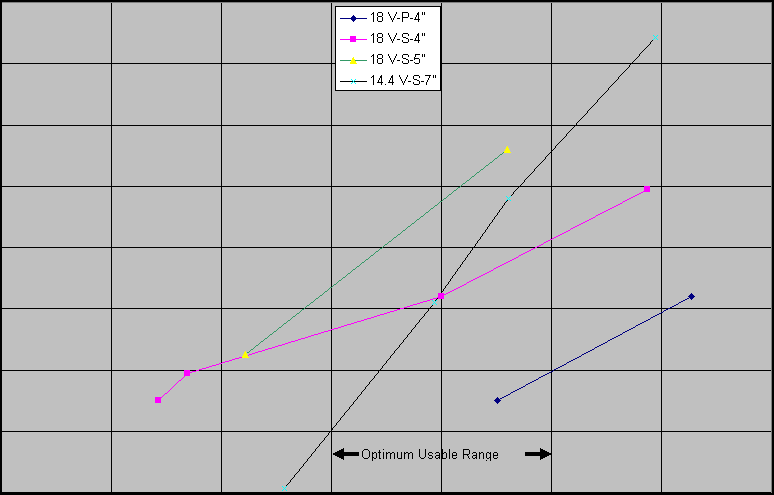
| |
 |
![]()
From the results of testing with an exercise bicycle I have come to the conclusion that approximate definition of pedaling speeds to be:
Slow -------- 50 RPM Medium ------ 70 RPM Fast -------- 90 RPM
The most optimum usable sustainable pedaling is slow to medium speed. Design the unit to allow a fast speed of 90 RPM without going over the rated drill speed, and then use it at less RPM.
G = P*R(D/d)
Or
d = (P*R*D)/G = (90*2.38*19.25)/550 = 7.5" diameter to give maximum power output for 14.4 volt and 12 volt drill units producing maximum power at fast pedaling speeds.
d = (90*2.38*19.25)/900 = 4.6" diameter to give maximum power output for 18 volt drill units producing maximum power at fast pedaling speeds.
In actual practice one finds that if the interfacing drive wheel is too small that it tends to slip or that too much spring tension is needed to keep it from
slipping. This causes inefficiency, drag, and can cause excessive ware on the drill bearings. If one uses bigger driver wheels then this is reduced. But
bigger wheels mean the drills will be turning at a slower speed and not generating maximum designed power. However, if the drill is capable of
producing more power than can easily be output in a sustainable mode then this is not a problem and one could easily pull back on the speed. This is
certainly the case with the 18 Volt drills. I found 5" diameter wheels to work best instead of the smaller 4.6" maximum power design determination. 4"
works but had too much slippage at medium speeds. Even the 5" has a tendency to slip at higher speeds.
For the 14.4 Volt drills I found that 7" diameter wheel worked just fine with minimal slippage at all speeds. I would chouse this setup over the 18 volt
as being more workable and comfortable to pedal. A 18 volt cordless drill might last longer than the lower voltage ones especially if one uses a series
hook up instead of parallel. The gear ratio is lower in this unit with less drag. Bottom line --- the above formula will get you into the ball park with
respect to chousing the best diameter for your generator drive wheel. After that building and testing it will refine the result. The bigger the wheel used
the slower the drill generators will turn given the same speed for input pedaling.
 This graph shows the
power output for
different RPMs of
pedaling speed.
This graph shows the
power output for
different RPMs of
pedaling speed.
18 V-P-4" stands for 18 volt drill wired in parallel using a 4" lawn mower wheel.
18 V-S-4" stands for 18 volt drill wired in series using a 4" lawn mower wheel.
18 V-S-5" stands for 18 volt drill wired in series using a 5" lawn mower wheel.
14.4 V-S-7" stands for 14.4 volt drill wired in series using a 7" lawn mower wheel.
Power from the first choice or the 14.4 Volt drills using a 7" wheel is about 10 to 55 watts in the optimum usable range of input pedaling speed. Power from second choice or the 18 Volt drills using a 5" wheel is about 35 to 60 watts in the optimum usable range of input pedaling speed. The 18 Volt units are estimated to last longer than the 14.4 volt when used in this application. A good non-slip wheel needs to be used and is the key if this is chosen. It is interesting to note that the open circuit voltage is equal to about 37 volts for either unit at a high non-sustainable pedaling speed of 106 RPM (14.4 volt drills) and 96 RPM (18 volt drills).
Offered by Mike.